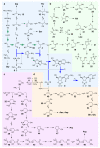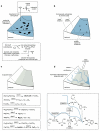Common origins of RNA, protein and lipid precursors in a cyanosulfidic protometabolism
- PMID: 25803468
- PMCID: PMC4568310
- DOI: 10.1038/nchem.2202
Common origins of RNA, protein and lipid precursors in a cyanosulfidic protometabolism
Abstract
A minimal cell can be thought of as comprising informational, compartment-forming and metabolic subsystems. To imagine the abiotic assembly of such an overall system, however, places great demands on hypothetical prebiotic chemistry. The perceived differences and incompatibilities between these subsystems have led to the widely held assumption that one or other subsystem must have preceded the others. Here we experimentally investigate the validity of this assumption by examining the assembly of various biomolecular building blocks from prebiotically plausible intermediates and one-carbon feedstock molecules. We show that precursors of ribonucleotides, amino acids and lipids can all be derived by the reductive homologation of hydrogen cyanide and some of its derivatives, and thus that all the cellular subsystems could have arisen simultaneously through common chemistry. The key reaction steps are driven by ultraviolet light, use hydrogen sulfide as the reductant and can be accelerated by Cu(I)-Cu(II) photoredox cycling.
Figures


Comment in
-
Origin of life: Primordial soup that cooks itself.Nat Chem. 2015 Apr;7(4):273-4. doi: 10.1038/nchem.2219. Nat Chem. 2015. PMID: 25803461 No abstract available.
Similar articles
-
Origin of life: Primordial soup that cooks itself.Nat Chem. 2015 Apr;7(4):273-4. doi: 10.1038/nchem.2219. Nat Chem. 2015. PMID: 25803461 No abstract available.
-
Conversion of biosynthetic precursors of RNA to those of DNA by photoredox chemistry.J Mol Evol. 2014 May;78(5):245-50. doi: 10.1007/s00239-014-9617-0. Epub 2014 Apr 16. J Mol Evol. 2014. PMID: 24736972 Free PMC article.
-
Resolving the History of Life on Earth by Seeking Life As We Know It on Mars.Astrobiology. 2022 Jul;22(7):880-888. doi: 10.1089/ast.2021.0043. Epub 2022 Apr 25. Astrobiology. 2022. PMID: 35467949 Free PMC article.
-
RNA: prebiotic product, or biotic invention?Chem Biodivers. 2007 Apr;4(4):721-39. doi: 10.1002/cbdv.200790060. Chem Biodivers. 2007. PMID: 17443885 Review.
-
The Origin of Life--Out of the Blue.Angew Chem Int Ed Engl. 2016 Jan 4;55(1):104-21. doi: 10.1002/anie.201506585. Epub 2015 Oct 29. Angew Chem Int Ed Engl. 2016. PMID: 26510485 Review.
Cited by
-
On the aqueous origins of the condensation polymers of life.Nat Rev Chem. 2024 Sep 27. doi: 10.1038/s41570-024-00648-5. Online ahead of print. Nat Rev Chem. 2024. PMID: 39333736 Review.
-
A potential role for RNA aminoacylation prior to its role in peptide synthesis.Proc Natl Acad Sci U S A. 2024 Aug 27;121(35):e2410206121. doi: 10.1073/pnas.2410206121. Epub 2024 Aug 23. Proc Natl Acad Sci U S A. 2024. PMID: 39178230 Free PMC article.
-
Kinetics and coexistence of autocatalytic reaction cycles.Sci Rep. 2024 Aug 8;14(1):18441. doi: 10.1038/s41598-024-69267-w. Sci Rep. 2024. PMID: 39117739 Free PMC article.
-
Protocellular Heme and Iron-Sulfur Clusters.Acc Chem Res. 2024 Aug 20;57(16):2293-2302. doi: 10.1021/acs.accounts.4c00254. Epub 2024 Aug 5. Acc Chem Res. 2024. PMID: 39099316 Free PMC article. Review.
-
Prebiotic thiol-catalyzed thioamide bond formation.Geochem Trans. 2024 Aug 5;25(1):5. doi: 10.1186/s12932-024-00088-6. Geochem Trans. 2024. PMID: 39098875 Free PMC article.
References
-
- Gánti T. The Principles of Life. Oxford University Press; 2003.
-
- Dyson F. Origins of Life. 2nd Ed. Cambridge University Press: 1999.
-
- Orgel LE. Prebiotic chemistry and the origin of the RNA world. Crit. Rev. Biochem. Mol. Biol. 2004;39:99–123. - PubMed
-
- Segré D, Ben-Eli D, Deamer DW, Lancet D. The lipid world. Origins Life Evol. Biosphere. 2001;31:119–145. - PubMed
-
- Wächtershäuser G. Groundworks for an evolutionary biochemistry: the iron-sulphur world. Prog. Biophys. Molec. Biol. 1992;58:85–201. - PubMed
Publication types
MeSH terms
Substances
Grants and funding
LinkOut - more resources
Full Text Sources
Other Literature Sources

